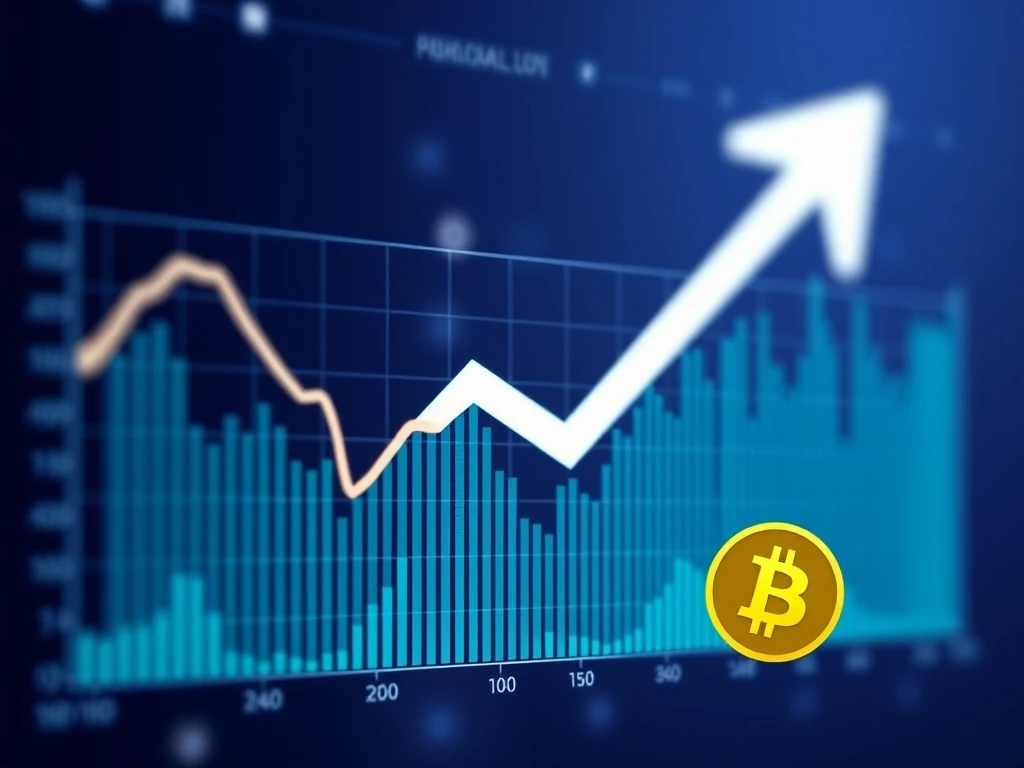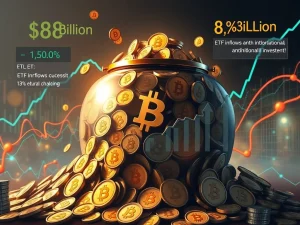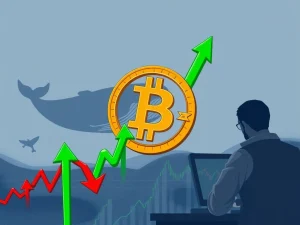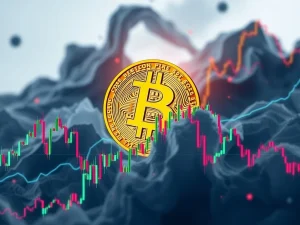Hopeful Sign? Bitcoin Exchange Inflows Plunge to 2-Year Low, Hinting at Bullish Reversal

Is the tide turning for Bitcoin? Crypto analysts are buzzing as weekly Bitcoin exchange inflows have hit levels not seen in nearly two years. This dramatic drop suggests a significant decrease in Bitcoin sellers, potentially paving the way for a much-anticipated bullish market resurgence. Let’s dive into what this could mean for the future of Bitcoin and the broader crypto market.
Bitcoin Sellers ‘Dry Up’: A Deep Dive into Exchange Inflows
Recent data reveals a compelling narrative: the relentless selling pressure on Bitcoin may be waning. According to insights from CryptoQuant, Bitcoin inflows to major exchanges have experienced a staggering decline – almost two-thirds since November. This isn’t just a minor dip; it’s a substantial shift that analysts believe could signal a critical juncture in the market cycle.
Axel Adler Jr., a contributor at CryptoQuant, highlighted this trend, stating that Bitcoin sellers have seemingly “dried up.” This observation is based on a sharp decrease in the 7-day average of total Bitcoin sent to exchanges for sale. Let’s break down the numbers:
- Peak Selling Pressure (November): Around 81,000 BTC per day were flowing into exchanges.
- Current Selling Pressure: This has plummeted to approximately 29,000 BTC per day.
- Percentage Decrease: A significant 64% reduction in sell-side pressure.
This dramatic reduction is illustrated in the chart below, showcasing the 7-day average Bitcoin exchange inflows:
Source: Axel Adler Jr./X (Chart showing the decline in Bitcoin exchange inflows)
Why are Lower Exchange Inflows a Bullish Signal for Bitcoin?
Reduced Bitcoin exchange inflows are generally considered a bullish indicator for several key reasons:
- Diminished Sell-Side Pressure: Fewer Bitcoins flowing into exchanges typically mean less immediate selling pressure in the market. This can help stabilize prices and create an environment conducive to price appreciation.
- Potential Supply Shortage: If sellers are holding onto their Bitcoin rather than sending it to exchanges, it can lead to a perceived or actual supply shortage. Basic economics dictates that reduced supply with stable or increasing demand can drive prices higher.
- Investor Confidence: Lower inflows might suggest that investors are less inclined to sell at current prices, indicating confidence in Bitcoin’s future prospects. They may be anticipating higher prices down the line.
- Market Maturation: This trend could reflect a maturing market where long-term holding and strategic accumulation are becoming more prevalent than short-term speculative selling.
Is a Bullish Market Turnaround Imminent?
While reduced Bitcoin exchange inflows are a positive sign, it’s crucial to consider the broader market context. Adler suggests that the market has successfully absorbed profit-taking waves following Bitcoin’s previous price surges. He posits that the current situation could be setting the stage for a “structural supply shortage.”
He further anticipates that April and May could become a “consolidation zone” – a period of relative price stability before the next potential upward “impulse.” This consolidation phase would allow the market to digest recent gains and potentially build a stronger foundation for future growth. Remember back in May 2023? 7-day average inflows were similarly low, and Bitcoin prices were under $30,000. Today, with prices significantly higher, the reduced selling pressure is even more noteworthy.
Market Analysis: Binance and Coinbase Divergence
Interestingly, recent market analysis points to a nuanced picture when examining specific exchanges. While overall inflows are down, there are variations between platforms like Binance and Coinbase.
According to Joao Wedson from Alphractal, Short Term Holders are exhibiting different behaviors on Binance compared to other exchanges:
| Exchange Group | Average BTC Inflows from Short Term Holders |
|---|---|
| Binance | 6,300 BTC |
| Other Exchanges (Average) | 24,700 BTC |
This data suggests:
- Lower Selling Pressure on Binance: Significantly fewer Bitcoins are being sent to Binance by short-term holders.
- Neutral Stance on Binance: Traders on Binance may be adopting a more neutral or wait-and-see approach, rather than actively selling.
- Coinbase Premium Neutral: The Coinbase Premium, a US-centric demand indicator, is also hovering around neutral levels, further reinforcing the idea of a market in a consolidation phase.
It’s important to note that short-term fluctuations can occur, and this week might even see a slight uptick in inflows on exchanges other than Binance. However, the overarching trend of reduced Bitcoin exchange inflows remains a compelling narrative.
Navigating the Market: Key Takeaways
The current situation presents a potentially exciting opportunity for Bitcoin enthusiasts. Here’s a summary of the key takeaways:
- Seller Exhaustion: Data strongly suggests a significant decrease in Bitcoin selling pressure, with exchange inflows at near 2-year lows.
- Bullish Potential: Reduced selling pressure and potential supply shortage could pave the way for a bullish market move.
- Consolidation Phase: April and May may represent a consolidation zone, offering a period of stability before the next potential price impulse.
- Nuance in Exchange Data: Analysis of specific exchanges like Binance and Coinbase provides a more granular view of market sentiment.
Looking Ahead: Is Bitcoin Poised for a Rebound?
While no one can predict the future with certainty, the confluence of reduced Bitcoin exchange inflows, potential seller exhaustion, and overall market sentiment paints a cautiously optimistic picture. As always, remember that the cryptocurrency market is volatile, and thorough research is crucial before making any investment decisions. However, the current data offers a glimmer of hope that the market may be gearing up for its next significant move. Keep an eye on those exchange inflows – they could be your early indicator of the next big wave in the Bitcoin market!
Disclaimer: This article is for informational purposes only and does not constitute investment advice. Always conduct your own research and consult with a financial advisor before investing in cryptocurrencies.










